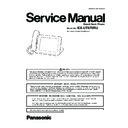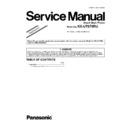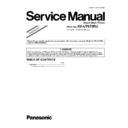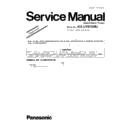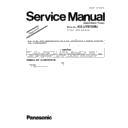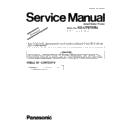Read Panasonic KX-UT670RU Service Manual online
ORDER NO. KMS1203885CE
Smart Desk Phone
Model No.
KX-UT670RU
(for Russia, Ukraine, Kazakhstan)
2
KX-UT670RU
TABLE OF CONTENTS
PAGE
PAGE
1 Safety Precautions -----------------------------------------------4
1.1. For Service Technicians ---------------------------------4
2 Warning --------------------------------------------------------------4
2.1. About Lead Free Solder (PbF: Pb free) --------------4
2.1.1. Suggested PbF Solder -------------------------------5
2.2. Discarding of P. C. Board --------------------------------5
3 Specifications ------------------------------------------------------6
4 Technical Descriptions------------------------------------------7
4 Technical Descriptions------------------------------------------7
4.1. Block Diagram ----------------------------------------------7
4.2. Power Supply Circuit --------------------------------------8
4.2. Power Supply Circuit --------------------------------------8
4.2.1. 12V Æ 3.3V ---------------------------------------------9
4.2.2. 12V Æ 5V -----------------------------------------------9
4.2.3. 3.3V Æ VDDP, VGH -------------------------------- 10
4.2.4. 5V Æ VGL, VDDN----------------------------------- 10
4.2.5. PoE ----------------------------------------------------- 11
4.2.2. 12V Æ 5V -----------------------------------------------9
4.2.3. 3.3V Æ VDDP, VGH -------------------------------- 10
4.2.4. 5V Æ VGL, VDDN----------------------------------- 10
4.2.5. PoE ----------------------------------------------------- 11
4.3. LCD Circuit------------------------------------------------- 12
4.4. LCD Backlight --------------------------------------------- 13
4.5. Touch Panel ----------------------------------------------- 13
4.6. Reset Circuit----------------------------------------------- 14
4.7. Ethernet Circuit ------------------------------------------- 14
4.8. Analog Circuit --------------------------------------------- 15
4.9. ASIC(IC403) ----------------------------------------------- 18
4.4. LCD Backlight --------------------------------------------- 13
4.5. Touch Panel ----------------------------------------------- 13
4.6. Reset Circuit----------------------------------------------- 14
4.7. Ethernet Circuit ------------------------------------------- 14
4.8. Analog Circuit --------------------------------------------- 15
4.9. ASIC(IC403) ----------------------------------------------- 18
4.10. USB Circuit ------------------------------------------------ 19
4.11. SD card ---------------------------------------------------- 19
4.12. Illuminance Sensor -------------------------------------- 20
4.13. Clock Circuit ----------------------------------------------- 20
4.13. Clock Circuit ----------------------------------------------- 20
4.13.1. 25MHz-------------------------------------------------- 20
4.13.2. 19.2MHz ----------------------------------------------- 20
4.13.3. 32.768kHz--------------------------------------------- 20
4.13.2. 19.2MHz ----------------------------------------------- 20
4.13.3. 32.768kHz--------------------------------------------- 20
4.14. Memory ----------------------------------------------------- 21
5 Location of Controls and Components------------------ 22
5.1. Name and Locations ------------------------------------ 22
6 Installation Instructions--------------------------------------- 26
6.1. Connections ----------------------------------------------- 26
7 Test Mode---------------------------------------------------------- 28
7.1. Touch Panel Test mode--------------------------------- 28
7.1.1. Key check --------------------------------------------- 29
7.1.2. LED check--------------------------------------------- 29
7.1.3. LCD check -------------------------------------------- 30
7.1.4. VCOM adjustment----------------------------------- 31
7.1.5. Brightness (USB function)------------------------- 31
7.1.6. Light sensor------------------------------------------- 32
7.1.7. Detect Device ---------------------------------------- 32
7.1.8. TSP(Touch Sensor Panel) Calibration --------- 32
7.1.9. QC Test ------------------------------------------------ 33
7.1.2. LED check--------------------------------------------- 29
7.1.3. LCD check -------------------------------------------- 30
7.1.4. VCOM adjustment----------------------------------- 31
7.1.5. Brightness (USB function)------------------------- 31
7.1.6. Light sensor------------------------------------------- 32
7.1.7. Detect Device ---------------------------------------- 32
7.1.8. TSP(Touch Sensor Panel) Calibration --------- 32
7.1.9. QC Test ------------------------------------------------ 33
7.2. Command Line Test Mode----------------------------- 35
7.2.1. Setting for PC ---------------------------------------- 35
7.2.2. Setting for PCB -------------------------------------- 35
7.2.3. TEST mode setting --------------------------------- 36
7.2.4. Test Mode Command------------------------------- 36
7.2.2. Setting for PCB -------------------------------------- 35
7.2.3. TEST mode setting --------------------------------- 36
7.2.4. Test Mode Command------------------------------- 36
8 Service Mode ----------------------------------------------------- 39
8.1. Factory Setting-------------------------------------------- 39
8.1.1. How to Clear User Setting ------------------------ 39
8.2. How to Change MAC Address Label---------------- 40
8.2.1. Replacing Main P.C.B. ----------------------------- 40
9 Troubleshooting Guide and Adjustments -------------- 41
9.1. No Power--------------------------------------------------- 41
9.1.1. Power Supply(AC adaptor) ----------------------- 43
9.1.2. Power Supply(PoE) -------------------------------- 44
9.1.3. Voltage and Clock Check ------------------------- 45
9.1.4. LED----------------------------------------------------- 46
9.1.3. Voltage and Clock Check ------------------------- 45
9.1.4. LED----------------------------------------------------- 46
9.2. LCD does not operate ---------------------------------- 47
9.3. Touch Panel does not operate ----------------------- 48
9.4. No Sound -------------------------------------------------- 49
9.3. Touch Panel does not operate ----------------------- 48
9.4. No Sound -------------------------------------------------- 49
9.4.1. Handset Does Not Work -------------------------- 49
9.4.2. Headset Does Not Work -------------------------- 49
9.4.3. SP-Phone MIC Does Not Work ----------------- 50
9.4.4. SP-Phone SP Does Not Work ----------------- 50
9.4.2. Headset Does Not Work -------------------------- 49
9.4.3. SP-Phone MIC Does Not Work ----------------- 50
9.4.4. SP-Phone SP Does Not Work ----------------- 50
9.5. EHS No function ----------------------------------------- 51
9.6. USB No Function ---------------------------------------- 51
9.7. SD card No Function ----------------------------------- 52
9.8. Sensor PCB. ---------------------------------------------- 52
9.9. LAN/PC port No Function ----------------------------- 53
9.6. USB No Function ---------------------------------------- 51
9.7. SD card No Function ----------------------------------- 52
9.8. Sensor PCB. ---------------------------------------------- 52
9.9. LAN/PC port No Function ----------------------------- 53
9.10. ASIC(IC403) Does Not Work ------------------------- 53
9.11. Adjustments ----------------------------------------------- 54
9.11.1. VCOM adjustment ---------------------------------- 54
9.11.2. TSP(Touch Sensor Panel) Calibration--------- 54
9.11.2. TSP(Touch Sensor Panel) Calibration--------- 54
10 Disassmbly and Assembly Instructions ---------------- 55
10.1. Remove the Lower Cabinet --------------------------- 55
10.2. Remove the Speaker Box ---------------------------- 56
10.3. Remove LCD Holder and Main Board ------------- 56
10.4. Assembly for Lead wire -------------------------------- 57
10.2. Remove the Speaker Box ---------------------------- 56
10.3. Remove LCD Holder and Main Board ------------- 56
10.4. Assembly for Lead wire -------------------------------- 57
11 Maintenance------------------------------------------------------ 58
11.1. Terminal Guide of the ICs Transistors and
Diodes ------------------------------------------------------ 58
11.1.1. Main Board ------------------------------------------- 58
11.1.2. Sub Board -------------------------------------------- 59
11.1.2. Sub Board -------------------------------------------- 59
11.2. How To Replace a Flat Package IC----------------- 60
11.2.1. Preparation ------------------------------------------- 60
11.2.2. Removal Procedure -------------------------------- 60
11.2.3. Procedure--------------------------------------------- 60
11.2.4. Removing Solder From Between Pins--------- 60
11.2.2. Removal Procedure -------------------------------- 60
11.2.3. Procedure--------------------------------------------- 60
11.2.4. Removing Solder From Between Pins--------- 60
11.3. Memo ------------------------------------------------------- 61
12 Schematic Diagram -------------------------------------------- 62
12.1. Main No.1-------------------------------------------------- 62
12.2. Main No.2-------------------------------------------------- 64
12.3. Main No.3-------------------------------------------------- 66
12.4. Main No.4-------------------------------------------------- 68
12.5. Main No.5-------------------------------------------------- 70
12.6. SUB Board ------------------------------------------------ 71
12.7. Waveform-------------------------------------------------- 72
12.2. Main No.2-------------------------------------------------- 64
12.3. Main No.3-------------------------------------------------- 66
12.4. Main No.4-------------------------------------------------- 68
12.5. Main No.5-------------------------------------------------- 70
12.6. SUB Board ------------------------------------------------ 71
12.7. Waveform-------------------------------------------------- 72
12.7.1. No.(1)-(6)---------------------------------------------- 72
12.7.2. No.(7)-(12) -------------------------------------------- 73
12.7.3. No.(13)-(18) ------------------------------------------ 74
12.7.4. No.(19)-(24) ------------------------------------------ 75
12.7.5. No.(25)-(30) ------------------------------------------ 76
12.7.6. No.(31)------------------------------------------------- 77
12.7.2. No.(7)-(12) -------------------------------------------- 73
12.7.3. No.(13)-(18) ------------------------------------------ 74
12.7.4. No.(19)-(24) ------------------------------------------ 75
12.7.5. No.(25)-(30) ------------------------------------------ 76
12.7.6. No.(31)------------------------------------------------- 77
13 Printed Circuit Board------------------------------------------ 78
13.1. Main Board ------------------------------------------------ 78
13.2. Jack Board ------------------------------------------------ 80
13.3. Hook Board------------------------------------------------ 80
13.4. Sensor Board --------------------------------------------- 80
13.2. Jack Board ------------------------------------------------ 80
13.3. Hook Board------------------------------------------------ 80
13.4. Sensor Board --------------------------------------------- 80
14 Appendix Information of Schematic Diagram -------- 81
3
KX-UT670RU
15 Exploded View and Replacement Parts List -----------82
15.1. IC Data ------------------------------------------------------82
15.1.1. IC1-------------------------------------------------------82
15.1.2. IC5-------------------------------------------------------90
15.1.2. IC5-------------------------------------------------------90
15.2. Cabinet and Electric Parts------------------------------95
15.3. Accessories and Packing Materials------------------96
15.4. Replacement Parts List ---------------------------------97
15.3. Accessories and Packing Materials------------------96
15.4. Replacement Parts List ---------------------------------97
15.4.1. Cabinet and Electrical Parts ----------------------97
15.4.2. Accessories and Packing Materials -------------97
15.4.3. Main Board Parts ------------------------------------97
15.4.4. Sub Board Parts------------------------------------ 104
15.4.2. Accessories and Packing Materials -------------97
15.4.3. Main Board Parts ------------------------------------97
15.4.4. Sub Board Parts------------------------------------ 104
4
KX-UT670RU
1 Safety Precautions
1. Before servicing, unplug the AC power cord to prevent an electric shock.
2. When replacing parts, use only the manufacturer's recommended components.
3. Check the condition of the power cord. Replace if wear or damage is evident.
4. After servicing, be sure to restore the lead dress, insulation barriers, insulation papers, shields, etc.
5. Before returning the serviced equipment to the customer, be sure to perform the following insulation resistance test to prevent
2. When replacing parts, use only the manufacturer's recommended components.
3. Check the condition of the power cord. Replace if wear or damage is evident.
4. After servicing, be sure to restore the lead dress, insulation barriers, insulation papers, shields, etc.
5. Before returning the serviced equipment to the customer, be sure to perform the following insulation resistance test to prevent
the customer from being exposed to shock hazards.
1.1.
For Service Technicians
• Repair service shall be provided in accordance with repair technology information such as service manual so as to prevent fires,
injury or electric shock, which can be caused by improper repair work.
1. When repair services are provided, neither the products nor their parts or members shall be remodeled.
2. If a lead wire assembly is supplied as a repair part, the lead wire assembly shall be replaced.
3. FASTON terminals shall be plugged straight in and unplugged straight out.
2. If a lead wire assembly is supplied as a repair part, the lead wire assembly shall be replaced.
3. FASTON terminals shall be plugged straight in and unplugged straight out.
• ICs and LSIs are vulnerable to static electricity.
When repairing, the following precautions will help prevent recurring malfunctions.
1. Cover plastic parts boxes with aluminum foil.
2. Ground the soldering irons.
3. Use a conductive mat on worktable.
4. Do not grasp IC or LSI pins with bare fingers.
2. Ground the soldering irons.
3. Use a conductive mat on worktable.
4. Do not grasp IC or LSI pins with bare fingers.
2 Warning
2.1.
About Lead Free Solder (PbF: Pb free)
Note:
In the information below, Pb, the symbol for lead in the periodic table of elements, will refer to standard solder or solder that
contains lead.
contains lead.
We will use PbF solder when discussing the lead free solder used in our manufacturing process which is made from Tin (Sn),
Silver (Ag), and Copper (Cu).
Silver (Ag), and Copper (Cu).
This model, and others like it, manufactured using lead free solder will have PbF stamped on the PCB. For service and repair
work we suggest using the same type of solder.
work we suggest using the same type of solder.
Caution
• PbF solder has a melting point that is 50
°F ~ 70 °F (30 °C ~ 40 °C) higher than Pb solder. Please use a soldering iron with
temperature control and adjust it to 700
°F ± 20 °F (370 °C ± 10 °C).
• Exercise care while using higher temperature soldering irons.:
Do not heat the PCB for too long time in order to prevent solder splash or damage to the PCB.
• PbF solder will tend to splash if it is heated much higher than its melting point, approximately 1100
°F (600 °C).
• When applying PbF solder to double layered boards, please check the component side for excess which may flow onto the
opposite side (See the figure below).

